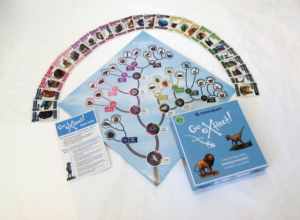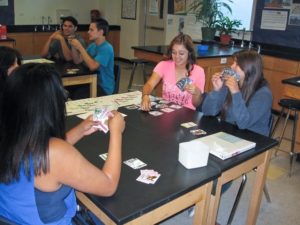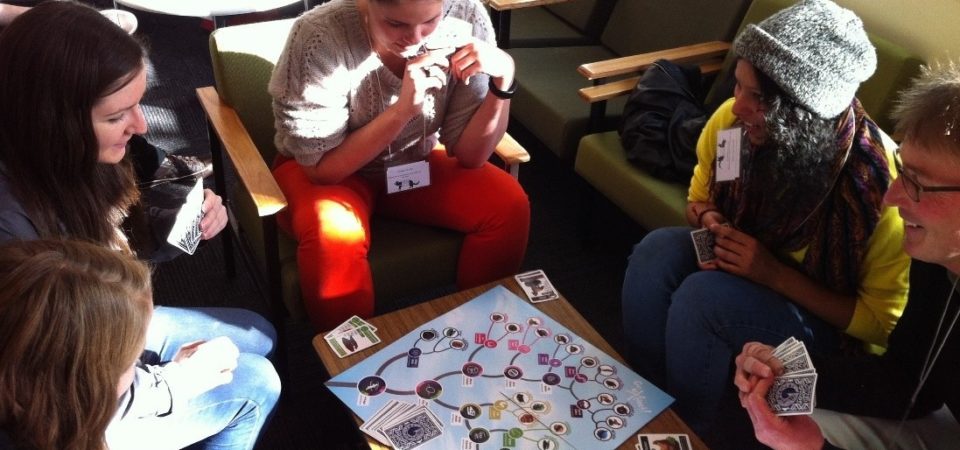When you think of children’s card games, evolutionary biology likely does not come to mind. Fulbright Scholar and University of Queensland evolutionary biology Ph.D. student, Ariel Marcy and the whole STEAM Galaxy Studios team are working to change this with the table-top game Go Extinct! –a game styled after Go Fish! that introduces players to the evolutionary tree. Through familiar rules, repetition, colorful illustrations, and entertaining descriptions, Go Extinct! makes the often intimidating tree diagram accessible. Which is critical, according to Marcy, because understanding the evolutionary tree is central to understanding evolutionary biology and how species, including ourselves, are connected through common ancestors.
Marcy began exploring the use of games in science education while she was at Stanford University –first as an undergraduate studying biology and computer science and later as an instructor of introductory human biology. Teaching this course, Marcy found that students were struggling to grasp how cells communicate and she was interested in finding a more creative and effective way for teaching the concepts. Drawing from the use of game development as a teaching tool in computer science, Marcy received a grant to develop Cancer Avenger. This initial project taught her a lot about the process of producing a game, including some pitfalls to be avoided, but also how useful games can be in the classroom for encoding complex concepts as an alternative to linear formats like lectures or readings.
With her own research concentrated in evolutionary biology, Marcy turned to finding a more effective way to teach the evolutionary tree –the powerful diagram at the heart of evolutionary biology. The tree’s non-linear, branching nature that can make it so intimidating, also made it a wonderful fit for a game. Organized as sets nested within larger sets, the evolutionary tree lends itself to adding more strategy to the familiar objective for players to “collect them all”. By adapting game mechanics from Go Fish!, incorporating an accurate though stylized evolutionary tree, and obsessively testing prototypes with different audiences, Marcy created Go Extinct!
Often tagged as “Go Fish! evolved”, the mechanics of Go Extinct! may be familiar:
 The game consists of 54 species cards and simplified, yet accurate, evolutionary tree board. To begin the game each player is dealt six cards. As a player, you are trying to collect ‘sets’ or clades of land vertebrates (the focus on land vertebrates is another reason for the tag line, as land vertebrates literally evolved from fish!). These sets are designated on the game board by color coding and also with playful, indicative names such as Slimeballs (aka Amphibians). Like in Go Fish! you use your turn to ask a specific opponent for a card that will move you closer to a set. Unlike in Go Fish! you do not have to ask for the exact card. In Go Extinct! you can ask for the exact card or any group on the tree that contains your card. You get to decide the best strategy: do you want to be specific and reveal more about your hand or do you want to be broad and hedge your bets? Skillful players can use the broad strategy to give away less information and increase the chances of getting something useful for two or more of the sets they are going for.
The game consists of 54 species cards and simplified, yet accurate, evolutionary tree board. To begin the game each player is dealt six cards. As a player, you are trying to collect ‘sets’ or clades of land vertebrates (the focus on land vertebrates is another reason for the tag line, as land vertebrates literally evolved from fish!). These sets are designated on the game board by color coding and also with playful, indicative names such as Slimeballs (aka Amphibians). Like in Go Fish! you use your turn to ask a specific opponent for a card that will move you closer to a set. Unlike in Go Fish! you do not have to ask for the exact card. In Go Extinct! you can ask for the exact card or any group on the tree that contains your card. You get to decide the best strategy: do you want to be specific and reveal more about your hand or do you want to be broad and hedge your bets? Skillful players can use the broad strategy to give away less information and increase the chances of getting something useful for two or more of the sets they are going for.
For example: You have the Elephant in your hand and are looking for the Aardvark to complete your Safari Star clade! You could ask directly for the Aardvark, for a Safari Star more generally, or be even more evasive and ask for a Big Baby (placental mammals) or even for a Warm Fuzzy (any mammal). The broader strategy is a great idea if you also have cards from another mammal clade.

In this way, the strategy of the game encourages players to learn how to use the evolutionary tree to find deeper common ancestors between the various animals they have in their hand. The interesting decision each round is how deep to make your ask based on your hand and what you can infer about other players’ cards. As the game continues, players are given multiple chances to interact with the tree, and the previously daunting network of relationships is reinforced through repetition. And of course, if at any point your opponent does not have a card that fits your ask, they get to say “Go Extinct!” and you are sent to pull a random card from the draw pile.
Playability was a huge priority for the STEAM Galaxy Studios when developing Go Extinct!. By using Go Fish! as the scaffolding, Go Extinct! has some amount of playability and familiarity built in –players are not trying to learn all new rules and new scientific concepts at the same time. The added strategy provided by the evolutionary tree, however, ensures that the game feels different each time based on the luck of the draw, who you’re playing with, and the strategies they decide to use. The team also includes RISD-trained illustrator Anita Tung who worked to develop accurate yet captivating images for the species cards and evolutionary tree. The cards and tree are color-coded to visualize the relationships. For example the light green Tail Losers (snakes & lizards) and dark green Dinosaurs are more closely linked to each other than to the purple Pouch Kids (marsupial mammals).
One of people’s favorite parts of the game, the playful nicknames, were actually a later change prompted by feedback from a 7th grader who was part of the games extensive beta-testing. The student pointed out that kids could not read or say the scientific names being used on the cards and board, and suggested fun nicknames be used instead. Recognizing that scientific names are really just nicknames in Latin, Marcy took this suggestion and ran with it, assigning punny nicknames that convey additional information about the clades themselves and the different evidence scientists use to categorize animals such as Warm Fuzzies for mammals and Finger Fliers for pterosaurs.
Go Extinct! not only provides an example of an engaging way to communicate complex scientific concepts, but also brings to the forefront the creativity inherent in all STEM (science, technology, engineering, and mathematics) fields – a primary goal of the STEAM Galaxy Studio and a huge part of Marcy’s own scientific career. Marcy suggests that the sciences do not just turn to the arts when looking for a creative way to communicate, but like art, creativity is inherent throughout the scientific process. Marcy can point to many moments when creativity and artistic tools helped elevate her research questions, figure out how to use existing methods to investigate new questions, convey the results intelligibly, connect interpretations to related literature, as well as create engaging presentations. She feels that more scientists should be encouraged, especially while in school, to explore the arts and think of science as powered by creativity. STEAM Galaxy Studios pushes for this through games, books, and toys for young people that situate the Arts within STEM, hence STEAM!
In this regard, the STEAM Galaxy Studios is just getting started. Next up is a dinosaur-specific version of Go Extinct! and an all-new game modeling how embryos reveal evolutionary relationships called Suddenly Cute. For those interested, they are always looking for new play testers, especially educators who are willing to give games a try in their classrooms. You can follow Ariel Marcy and stay up to date as the game develops.
The games can be purchased through Amazon.com or the STEAM Galaxy website. One of the objectives of STEAM Galaxy Studios is to diversify engagement with the STEM fields and is committed to removing barriers to using their games. Educators can purchase a discounted classroom set or access the free print-and-play version through the STEAM Galaxy website’s For Educators page. This page also includes extensive Next Generation Standards Alignment documentation.
This post is part of the MAHB’s Arts Community space –an open space for MAHB members to share, discuss, and connect with artwork processes and products pushing for change. Please visit the MAHB Arts Community to share and reflect on how art can promote critical changes in behavior and systems and contact Erika with any questions or suggestions you have regarding the new space.
MAHB-UTS Blogs are a joint venture between the University of Technology Sydney and the Millennium Alliance for Humanity and the Biosphere. Questions should be directed to joan@mahbonline.org.
MAHB Blog: https://mahb.stanford.edu/blog/demystifying-science/
The views and opinions expressed through the MAHB Website are those of the contributing authors and do not necessarily reflect an official position of the MAHB. The MAHB aims to share a range of perspectives and welcomes the discussions that they prompt.
